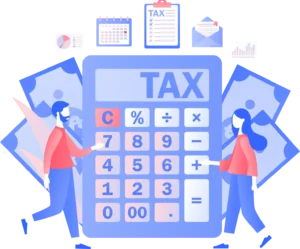Taxes in Canada are the backbone of the country's economy. Taxes fund crucial services like healthcare, education, and infrastructure. The Canadian tax system involves income, sales, property, and corporate taxes. Given this multifaceted approach, you must clearly understand how taxes work in Canada, the responsibilities of Canadian citizens, and the importance of compliance with the Canada Revenue Agency (CRA) regulations.
Advertisements
Income tax basics
With the right preparation and knowledge, you can manage your taxes efficiently, ensuring compliance and maximizing your financial health.
Creditpicks
Tweet
The Income Tax Act regulates income-related taxation in Canada. Income tax is the most significant source of revenue for the Canadian government. The federal and provincial/territorial governments levy income taxes on individuals and corporations.
For individuals, taxable income includes employment, capital gains, and rental income—among others. Taxable income is subject to a progressive tax system, meaning the tax rate increases as income rises, to ensure fairness and equity in the tax system.
Federal and provincial taxes
Canada's federal tax rates are structured in brackets, with rates increasing for higher income levels. Canada’s 2024 Marginal Taxes Rates are as follows:
- First $55,867: 15%
- Over $55867 up to $111,733: 20.50%
- Over $111,733 up to $173,205: 26.00%
- Over $173,205 up to $246,752: 29.32%
- Over $246,752: 33%
In addition to federal taxes, residents also pay provincial or territorial taxes, which vary across the country. For instance, British Columbia and Nova Scotia have their own specific tax rates and brackets. Understanding federal and provincial tax rates is crucial for accurately calculating tax obligations.
Advertisements
Provincial and territorial tax rates

Tax rates vary by province and territory. Here's a simplified table highlighting the differences:
| Province/territory | Lowest rate (%) | Highest rate (%) |
| Alberta | 10.00 | 15.00 |
| British Columbia | 5.06 | 20.05 |
| Manitoba | 10.80 | 17.40 |
| New Brunswick | 9.40 | 19.50 |
| Newfoundland and Labrador | 8.70 | 21.80 |
| Nova Scotia | 8.79 | 21.00 |
| Ontario | 5.05 | 13.16 |
| Prince Edward Island | 9.65 | 18.75 |
| Quebec | 14.00 | 25.75 |
| Saskatchewan | 10.50 | 14.50 |
| Northwest Territories | 5.90 | 14.05 |
| Nunavut | 4.00 | 11.50 |
| Yukon | 6.40 | 15.00 |
Note: Rates are for the 2024 tax year and may vary.
Sales tax and GST/HST
Sales taxes in Canada are another key component of the tax system, with the Goods and Services Tax (GST) and Harmonized Sales Tax (HST) being prevalent. While GST is a federal tax levied at 5% on most goods and services, the HST combines the GST and provincial sales tax, applicable in certain provinces. Consumers pay this tax at the point of sale on most purchases.
Notably, only GST is levied in Alberta, Nunavut, and the Northwest Territories. There is no PST and HST paid in this province or these territories.
Property and corporate taxes
Property taxes are levied by local municipalities on property owners based on the assessed value of their real estate. These taxes fund local services such as garbage collection, water, and schools.
Corporate taxes apply to the income of corporations operating in Canada, with rates depending on the province or territory. Understanding these taxes is essential for both homeowners and business owners in Canada.
Advertisements
Tax credits and deductions
The Canadian tax system offers various credits and deductions to reduce the tax burden on individuals and corporations. Credits like the Canada Child Benefit and deductions such as contributions to a Registered Retirement Savings Plan (RRSP) can significantly lower the amount of tax owed. The dividend tax credit and medical expenses are designed to alleviate taxpayers' financial load.
Using tax credit
Tax credits and deductions can directly reduce the amount of tax you owe. Commonly used credits and deductions include the following:
- Canada Child Benefit: A tax-free monthly payment made to eligible families to help with the cost of raising children.
- GST/HST Credit: Designed to offset the GST or HST paid by lower-income families and individuals.
- Dividend Tax Credit: Reduces the tax owed on income earned from Canadian corporations.
- RRSP contributions: Contributions to a Registered Retirement Savings Plan are deductible from your total income, reducing the income tax you owe.
- Childcare expenses: Parents can deduct childcare expenses, including day care, nursery school, and after-school care.
- Medical expenses: You can claim various medical expenses, including prescriptions, dental services, and medical equipment.
This list is not exhaustive. Additional tax credits and deductions may include the Disability Tax Credit or the Registered Disability Savings Plan. Consult with a local tax professional for more information on maximizing your return.
We’re fans of Gabrielle Talks Money on YouTube. Check out this video on the 2024 changes you must be aware of.
Filing taxes in Canada

Filing a Canadian tax return is an annual obligation for most residents and corporations. The process involves reporting income, claiming deductions and credits, and calculating the amount of tax owed or the refund due.
The CRA offers multiple filing options, including electronic submissions through NETFILE and paper returns. For international students, U.S. expats, and those filing for the first time, understanding residency status, worldwide income, and eligible deductions is crucial.
Submitting your tax return to the CRA
Completing and submitting your tax return accurately is vital. Here are key steps and tips for a smooth process:
- Collect all necessary documents: Include T4 slips, investment income statements, and receipts for eligible deductions and credits.
- Choose your filing method: Options include using NETFILE with certified tax software, mailing a paper return, or using a tax professional.
- Understand key deadlines: Typically, April 30 is the deadline for most individuals, with June 15 for self-employed persons, to avoid penalties.
- Review thoroughly before submitting: Ensure all information is accurate to prevent delays or audits.
Charlee Wayne outlines how to file your taxes for free in the following video:
Special considerations
Be aware of your specific circumstances and how they might affect your filing. The following are some common special considerations:
- U.S. expats: Must report worldwide income but can claim foreign tax credits to avoid double taxation.
- International students: May need to file a tax return if they have earned income in Canada or want to claim a refund.
Advertisements
Understanding and addressing complexities
Understanding the Canadian tax system's nuances, from different tax rates across provinces to specific credits and deductions, is crucial for optimizing your tax situation. Available resources, such as the CRA website and professional tax services, can provide clarity and assistance throughout the tax season.
Taxes are good for everyone (believe it or not)
Maintaining compliance with the tax system in Canada is a significant responsibility for residents. However, with the right preparation and knowledge, you can manage your taxes efficiently, ensuring compliance and maximizing your financial health.
Whether you're filing for the first time or looking to optimize your tax situation, remember that resources are available, from the CRA's extensive online guides to professional tax advisors.
Get organized, stay informed
Now that you're equipped with a deeper understanding of taxes in Canada, it's time to act. Start by organizing your documents, exploring eligible deductions and credits, and choosing the best filing method.
Creditpicks has an extensive article library that addresses various tax-related items, credits, and deductions. Ensure you check back often for updates or subscribe to our mailing list for the latest articles and special partner offers.
Advertisements




